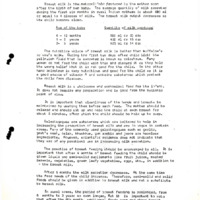BREAST FEEDING
Item
- Title
- BREAST FEEDING
- extracted text
-
SDA-RF-CH-1.54
BRE8ST
FEEDING
NATIONAL INSTITUTE OF NUTRITION
MEDICAL RESEARCH
INDIAN COUNCIL OF
Breast milk is theu.net arallfobd produced by the mother soon
after the birth of her baby. The average quantity of milk secreted
during the first six months in rural Indian mothers is about 600 ml
or equal to 4 glasses of milk. The breast milk output decreases as
the child becomes older.
Aqe of the babv
6-12 months
1 - 2 years
2- 3 years
Quantity of milk oroduced
600 ml or 20 ozs
450 ml or 15 ozs
425 ml or 14 ozs
The nutritive valuve of brea'st milk is better than buffaloe's
or cow's milk. During the first two days after child birth the
yellowish fluid that is secreted is known as colostrum. Many
women do not feed the child with this and discard it as they hold
the wrong belief that it is not good for the child.
Cn the other
hand colostrum is very nutritious and good for the child as it is
a good source of vitamin A and contains substances which protect
the child from diseases.
Breast milk is a wholesome and economical food for the infant.
It does not require any preparation and is good from the hygienic
point of view.
It is important that cleanliness of the hands and breasts be
maintained by washing them before each feed. The mother should be
relaxed and should sit up and hold the child at each breast for
about 5 minutes, after which the child should be held up to burp.
Galactogogues are substances which are believed to help in
increasing the production of breast milk and are in vogue in certain
areas. Many of the commonly used galactogogues such as garlic,
goat's meat, palak, khuskhus, gum arable and jeera are harmless
ingredients. However, scientific evidence does not indicate that
they are of any practical use in increasing milk secretion.
The practice of breast feeding should be encouraged by all.
It is
important that after 4 months of breast feeding the child should be
given liquid and semi-solid supllements like fruit juices, mashed
cereals, vegetables, green leafy vegetables, eggs, etc., in addition to
"n the breast milk.
After 6 months the milk secretion decreases. At the same time
the food needs of the child increase. Therefore, semi-solid and solid
foods should be given in addition to breast milk and not a substitute
to breast milk.
In rural areas, the period of breast feeding is prolonged, from
6 months to 3 years or even longer, But it is important to note
that after the 6th month, additional foods over and above breast
milk are essential.
Cont
2
Though breast milk ..is easily available from the mother,
", breast feeding is a greater strain on the mother than is preg
nancy because the woman nourishes a fully developed and rapidly
growing baby whose food needs increase day by day.
In order to breast feed her infant without any undue strain
on her own body, she must continue to eat an adequate and
balanced diet to meet the requirement of lactation.
Both in quantity and quality the food eaten by nursing
mothers in poor Indian communities does not differ appreciably
from that consumed by them during pregnancy, or-at other times.
Inspite of faulty and inadequate diet of the mother the
quality of breast milk does’ not usually suffer. This is
because the. nutrients are drawn from the mother’s bones and
tissues for milk production.
Continuous stress on the mother may result in her illhealth
and reduction in quantity of her milk. Such a drain on the
mother's tissue must be checked by providing the mother with a
nourishing and adequate diet.
The diet must include plenty of cereals, pulses, green
leafy vegetables and milk.
If possible, animal food like meat,
fish and eggs should be included in the diet.
Regular consumption of certain foods from each food group
. daily would make the diet wholesome and ensure the. health of
;■ the mother.
******
- Media
 SDA-RF-CH-1.54.pdf
SDA-RF-CH-1.54.pdf
Position: 2904 (3 views)
